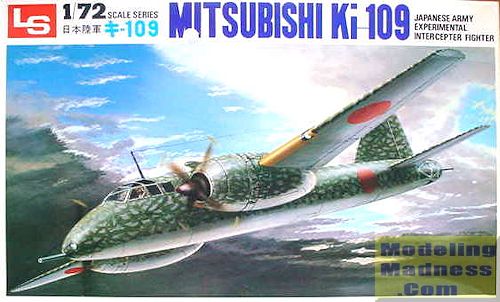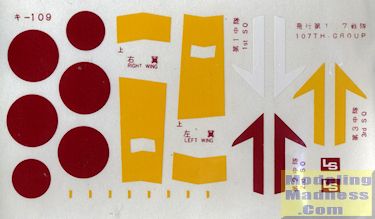
LS 1/72 Ki-109
| KIT #: | A-603 |
| PRICE: | $ |
| DECALS: | Three options |
| REVIEWER: | Scott Van Aken |
| NOTES: | First released in 1966 |

| HISTORY |
A development of the Ki-67 heavy bomber was the Ki-109 Army Heavy Fighter Interceptor: First non-prototype model of series. Lacking gun positions in upper and side positions and without bomb-bay compartments. Fixed 75 mm Type 88 Heavy Cannon in the nose retained from Day Fighter prototype. Had a revised version of tail gun. 22 constructed by Mitsubishi.
The Japanese were never really able to develop engines that operated well at high altitude and with the impending US use of the B-29, the JAAF was left scrambling to develop aircraft that could not only perform at altitude, but also have enough punch to bring down a Superfortress. Developed from an earlier ground attack aircraft, the Ki-109 was hoped to have what was needed to do the job. Unfortunately, like many late war projects, it was not only too little, too late, but the aircraft did not perform as hoped at altitude. There is no record of any successes by the Ki-109.
| THE KIT |
 I
have had this kit since LS was still a going concern and true to my then-kit
collecting ways, it still had the shrink wrap on it from the importer (most kits
sold outside the US are not shrink wrapped to cut down on not only cost, but
also on plastic pollution). Forgive me for not showing the actual sprues as I
wanted to keep this one in the bag as there were a lot of loose parts.
I
have had this kit since LS was still a going concern and true to my then-kit
collecting ways, it still had the shrink wrap on it from the importer (most kits
sold outside the US are not shrink wrapped to cut down on not only cost, but
also on plastic pollution). Forgive me for not showing the actual sprues as I
wanted to keep this one in the bag as there were a lot of loose parts.
Included in those loose parts was a clear fuselage half and a clear engine cowling. These are not shown on the parts diagram. I had heard that older LS kits (and this one is dated 1966), were 1/75 scale so I measured one of the wings. It came to 5 1/8 inches. I then measured the wing on my Hasegawa Ki-67 and it measured over 5 1/2 inches so this one is, indeed, 1/75 scale. I'll have to be sure not to set them next to each other if I build this one.
In addition to the usual grey sprues, the sprue that holds the engines and wheels is molded in black plastic. The engines are generic cylinders on a hub with no real detail. However, these engines have a cooling fan in front of them and though the one in the LS kit is pretty open, it still looks like it will hide some of that detail.
The cockpit consists of a nice floor section that houses the pilot and navigator/radio operator. There is a stepped down section that has the big cannon and the gunner. Apparently each round had to be manually loaded. There is a bomb bay, but not to worry as the bay doors are molded closed on the fuselage halves. There is a ventral stair that is apparently a 'working' feature as are the tail gear doors. In the very back is the standard Ki-67 tail gun position with its multi-panel greenhouse.
Typical of kits from this era, we have separate ailerons and flaps. One can move both of these items with the flaps being able to be pulled out a bit before lowering them. I already covered the engines but need to mention that each has an engine mount and in front of it is fit a four blade prop with separate spinner. Main wheels are in two halves and snap into the main gear legs. These are also apparently able to be retracted (like the tail gear) as the main gear doors are on hinges. In addition to three crew members, the kit contains two ground crew.
 Instructions
are totally Japanese and there are a few notes that will require some sleuthing
to figure what they are talking about. Markings are for three planes, all from
the 107 Sentai, and each has a different tail marking color. The decal sheet is
nicely printed, though its effectiveness will be unknown until one gives them a
go. Fortunately, there is nothing really complex so if painting becomes a
requirement, it won't be a major issue. I should also mention that a small tube
of glue is included. All the marking options are in JAAF green grey overall with
upper surfaces in various types of mottling. I am guessing that in reality, only
the control surfaces were in green grey and the rest of the base airframe was
unpainted metal. The sheet also includes the leading edge ID bands, but I'd
paint those on. There are some photos on the net that may be useful when it
comes to painting, but not many.
Instructions
are totally Japanese and there are a few notes that will require some sleuthing
to figure what they are talking about. Markings are for three planes, all from
the 107 Sentai, and each has a different tail marking color. The decal sheet is
nicely printed, though its effectiveness will be unknown until one gives them a
go. Fortunately, there is nothing really complex so if painting becomes a
requirement, it won't be a major issue. I should also mention that a small tube
of glue is included. All the marking options are in JAAF green grey overall with
upper surfaces in various types of mottling. I am guessing that in reality, only
the control surfaces were in green grey and the rest of the base airframe was
unpainted metal. The sheet also includes the leading edge ID bands, but I'd
paint those on. There are some photos on the net that may be useful when it
comes to painting, but not many.
| CONCLUSIONS |
So what you are left with is a relatively easy to find kit of a rather obscure Japanese aircraft. It is a child of the '60s with all its operating parts and is underscale. There is a more modern version that was kitted in their Limited Edition series by Hasegawa in 2000 and again in 2013. It was quickly snapped up and can be difficult to find. This basically leaves the LS kit.
| REFERENCES |
http://en.wikipedia.org/wiki/Mitsubishi_Ki-67
December 2014 Thanks to me for
providing the preview kit. If you would like your product reviewed fairly and fairly quickly, please contact the editor or see other details in the
Note to
Contributors.